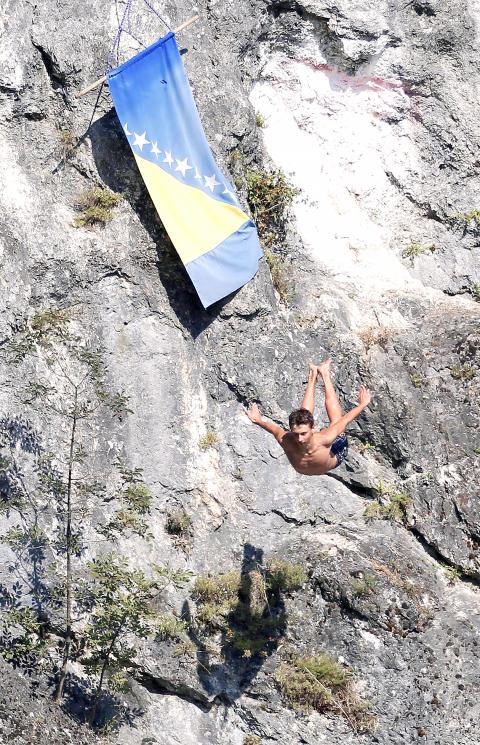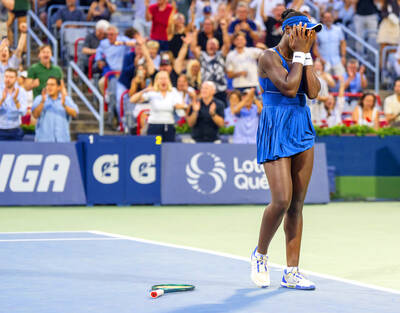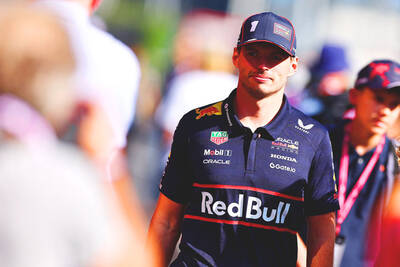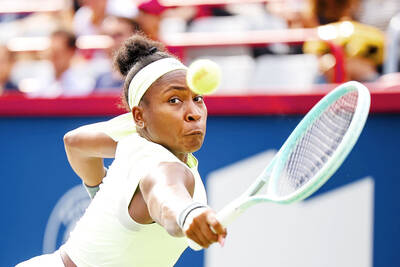“Even the tiniest mistake can be fatal,” says Said Karalic, a veteran of a daring cliff diving competition that draws the Balkans’ most intrepid divers to this Bosnian swimming hole every August.
The site is a steep grey cliff that stands over the Neretva River right in front of the public beach in Konjic, a small town 60km southwest of the capital, Sarajevo.
The river runs shallow here except for one “hole” — a pool only 2m in diameter and 2m deep surrounded by jagged rocks, a potential death trap under the striking green water.

Photo: AFP
It is known as the Kazan or “pot,” where young Konjic men have proved their courage for decades.
However, word spread and in the past 16 years it has become an annual “must” for the best divers in the Balkans.
Konjic’s 18m cliff is far from the tallest in high diving, a discipline only admitted into official competition for the first time last month at the World Swimming Championships in Barcelona.
Yet here, there is no room for error as the high diver aims for the small “hole” in otherwise knee-deep waters.
“The flight takes one to two seconds. A man is not a bird, and if we make a mistake we have no time to correct it,” Karalic said.
The graying 55-year-old with short-cropped hair knows better than most. A tattoo on his chest of a man plunging head-first in a “swallow,” or “swan” dive commemorates his first successful “leap of death” in 2001, a distinction few can claim.
While Konjic’s classic high dive is made from 18m, those attempting the “leap of death” must climb 25m up the cliff before plunging into the hole. And there are not too many divers who dare.
The Konjic competition has no international standing and the jumpers’ only reward is a medal for bravery. And despite the danger, no one has ever died.
Locals remember only one accident years ago and even that was not serious, they say, because “only the best divers” come to Konjic.
At this year’s event, Karalic, nowadays a referee, took his place alongside six other judges on a beach platform facing the cliff.
Sixteen divers from Bosnia, neighboring Serbia and Montenegro, competed in two series of jumps, including 25-year old local diver Danko Dangbic, the Konjic champion for the past three years.
Hundreds of spectators applauded and shouted, but when Dangbic reached the diving point, all went silent.
He raised his left hand to signal he was ready, focused on the “pot” below, spread his arms then dived. Seconds later, his head bobbed out of the cold water looking straight at the judges. Yes, his dive was perfect.
“It’s more the mind than the muscles,” he said. “It’s the dive that requires concentration and perfect fitness, one cannot afford any mistakes.”
His advice to future divers: “Determination and courage are crucial.”
“Even the best possible physical fitness cannot help the jump if you are not brave,” he said.
Dino Bajric, 24, the second-place winner, sports a shiny silver medal around his neck and readily admits that it is the adrenaline rush that draws him to high diving.
“It is the challenge, the height, the freedom we feel in the air. These few seconds are indescribable,” he said.
“I feel as free as a bird. The space belongs to you during the flight, even if this feeling lasts only briefly, until you hit the water,” he added. “Then it really hurts.”

Taiwan’s top women’s badminton doubles duo, Hsieh Pei-shan (謝沛珊) and Hung En-tzu (洪恩慈), achieved a straight-sets victory over Japan’s Kaho Osawa and Mayui Tanabe at the Badminton World Federation (BWF) Super 300 Macau Open on Sunday. The Taiwanese pair won the final 21-18, 21-12, marking the duo’s second title this year after their win at the BWF Super 300 Taipei Open in May. The match on Sunday was their first encounter with the Japanese duo, ranked No. 63 in the world. Hsieh and Hung, ranked No. 12, began the opening game well. Hung, who plays left-handed, performed strongly at both the net and the

Canadian teenager Victoria Mboko upset top-seeded Coco Gauff 6-1, 6-4 on Saturday night to reach the National Bank Open quarter-finals. “Your support was incredible,” Mboko told the crowd in French after a chorus of “Ole, Ole, Ole” chants echoed around the venue. “I’m really happy to win today ... It’s incredible. I’m so happy to beat such a great champion.” Gauff dropped to 2-3 since winning the French Open. She followed the major victory with opening losses in Berlin and Wimbledon, then overcame double-fault problems to win two three-set matches in Montreal. Gauff had five double-faults on Saturday after having 23 in

Formula 1 champion Max Verstappen on Thursday said that he is staying with the Red Bull team next year, ending months of speculation over his future. “Some people just like to stir the pot, some people just like to create drama, but, for me, it’s always been quite clear, and also for next year,” the four-time champion said ahead of the Hungarian Grand Prix. “I’m discussing with the team already the plans — the things that we want to change for next year, so that means that I’m also staying with the team for next year,” he said. Verstappen has a contract with

Alex Michelsen on Thursday rallied for a 3-6, 7-6 (7/4), 6-4 upset victory over third-seeded Lorenzo Musetti in the men’s singles, converting his seventh match point to reach the fourth round of the Canadian Open. Michelsen reached the last 16 of a Masters 1000 for the first time with his second win over a top-10 player in eight attempts. The 20-year-old American survived nearly 50 unforced errors and converted just two of nine break chances, but it was enough to vanquish Italy’s Musetti, a two-time Grand Slam semi-finalist ranked 10th in the world. “It feels really good,” the 26th-ranked Michelsen said. “I’ve put